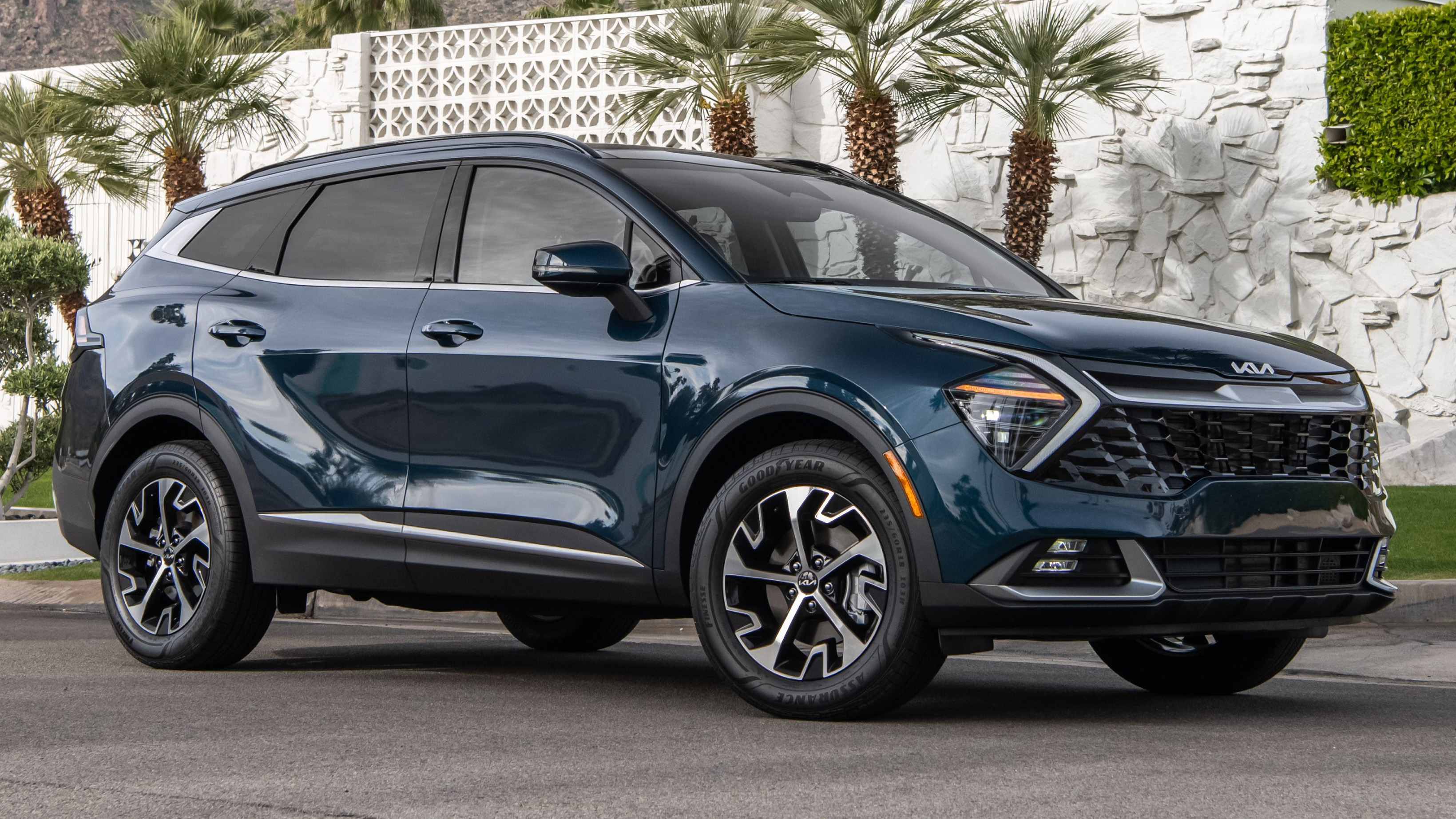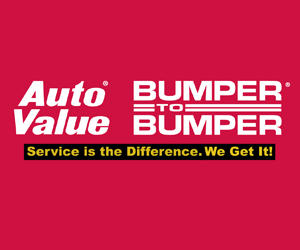2023 Kia Sportage
The Sportage Has Grown Up
The Sportage is Kia’s longest-running American nameplate, arriving in the mid-1990s before compact SUVs were really even a thing. Well, as we all know, the Kia brand has grown a lot since then, and so has the Sportage. So, let’s check out this 5th-gen Sportage, and see how much more it offers to reel in today’s savvy crossover buyers.
 The Sportage has grown up. That’s the best way to sum up this 2023 Kia Sportage. It not only looks much larger than before, but every exterior dimension of this compact utility has indeed increased. It’s more than 7-inches longer than before, with a wheelbase stretch of 3.4-inches; height and width grow less dramatically, both by about half an inch. All helping it transform from one of the smallest vehicles in the compact utility segment to one of the largest.
The Sportage has grown up. That’s the best way to sum up this 2023 Kia Sportage. It not only looks much larger than before, but every exterior dimension of this compact utility has indeed increased. It’s more than 7-inches longer than before, with a wheelbase stretch of 3.4-inches; height and width grow less dramatically, both by about half an inch. All helping it transform from one of the smallest vehicles in the compact utility segment to one of the largest.
It looks more mature too, with Kia’s tiger nose grille taking on a “floating” design, bookended by unique daytime running lights. Hybrids come with 17-inch wheels, but these 18s are an option. That larger size allows for 39.5 cubic-ft. of rear cargo space, which compares favorably with many midsize utilities; max capacity with seatbacks folded is 73.7 cubic-ft.
It also feels more stable too, with a ride quality that’s very smooth for a small SUV; quite comfortable as well; some staffers declaring it was even more comfy and spacious feeling inside than Kia’s midsize Sorento. Adding to the airy feel is an enormous panoramic sunroof.
There’s plenty of glass on the dash as well; side-by-side 12-inch screens for instrumentation and infotainment. Just below the central screen is a panel with a mix of traditional and touch controls for climate and the radio, which in top SX-Prestige trim is a Harmon/Kardon 8-speaker premium system. Thoughtful placement of the multiple storage nooks with USB ports for charging adds greatly to overall usability. Rear seat passengers get some of the best legroom in the compact class, along with reclining seatbacks.
 Standard engine for the new Sportage is a 187-horsepower naturally aspirated 2.5-liter I4. But we highly recommend stepping up to this Hybrid; its combined 1.6-liter turbo I4 and 44-kW electric motor are truly a best of both worlds scenario, delivering 40 additional horsepower, 80 more lb-ft. torque, and better fuel economy. Kia even gives you a tried and true 6-speed automatic transmission. On top of all that, the hybrid powertrain just feels much more responsive, and allows more than 500-miles of driving on a tank of gas.
Standard engine for the new Sportage is a 187-horsepower naturally aspirated 2.5-liter I4. But we highly recommend stepping up to this Hybrid; its combined 1.6-liter turbo I4 and 44-kW electric motor are truly a best of both worlds scenario, delivering 40 additional horsepower, 80 more lb-ft. torque, and better fuel economy. Kia even gives you a tried and true 6-speed automatic transmission. On top of all that, the hybrid powertrain just feels much more responsive, and allows more than 500-miles of driving on a tank of gas.
You can still get all-wheel-drive too, which comes with tweaked suspension to add an additional inch of ride height; though it does impact fuel economy quite a bit. Government Fuel Economy Ratings with all-wheel-drive are 38 across the board for City, Highway, and Combined. We got close with a 36.5 miles-per-gallon average on Regular. The front drive version’s Combined rating is 43.
For numbers of a different kind, it was off to Mason Dixon Dragway.
After launching strictly on battery power, the gas engine quickly kicks in. The tach sweeps past 3,000 RPM, and you can really feel some power coming on. We hit 60 in 7.7-seconds, a quite acceptable result for a mainstream compact SUV.
 That 6-speed transmission that we very much appreciated in daily use felt a little clunky here at the track; and this little turbo tends to sound more whiney than pleasing. But ultimately, the ¼-mile run is fairly smooth and uneventful; completed in a quite good 15.8-seconds at 90 miles-per-hour. Being based on Hyundai-Kia’s midsize N3 platform pays major dividends when it comes to handling.
That 6-speed transmission that we very much appreciated in daily use felt a little clunky here at the track; and this little turbo tends to sound more whiney than pleasing. But ultimately, the ¼-mile run is fairly smooth and uneventful; completed in a quite good 15.8-seconds at 90 miles-per-hour. Being based on Hyundai-Kia’s midsize N3 platform pays major dividends when it comes to handling.
The Hybrid adds $1,300 to a base Sportage LX, putting it at $28,585; all-wheel-drive adds $1,800 more. The Hybrid is only available in LX, EX, and SX-Prestige trims; topping out at $37,485. A plug-in hybrid with up to 32-miles of EV range will soon join the party.
The Sportage has played a major role in the Kia story from the very beginning; and it seems we’re really getting to the good part of the book where the main characters go through major transformations that impact where the story goes from here. The Chronicles of Kia are far from their conclusion, but the 2023 Kia Sportage is the plot twist we’ve all been waiting for, and will certainly have us anticipating what’s to come next.
Specifications
- Engine: 2.5L I4 | 1.6L Turbo-4
- Horsepower: 187 | 227
- Torque: 178 lb-ft | 258 lb-ft
- 0-60 mph: 7.7 seconds
- 1/4 Mile: 15.8 seconds at 90 mph
- EPA: 38 combined (AWD) | 43 combined (FWD)
- 60-0 Braking: 116 feet (avg)
2024 Hyundai Elantra
Basic Transportation At Its Best…And That Is A Compliment
For those of you who write in every week bemoaning the fact that all we seem to do around here is test incredibly expensive cars and EVs that only the very well to do can afford, this one’s for you. It’s a commuter and budget friendly mainstay from Hyundai, the compact Elantra sedan. And, it has been nicely updated for 2024.
We clearly do enjoy driving high-performance machines and ultra-luxury rides around here, but like most of you, when it comes time to drive home at the end of a long workday, we do so in something much more practical and affordable, like this 2024 Hyundai Elantra sedan.
If you’re thinking the front end has gotten more aggressive, you’re right. Hyundai calls it a “Shark Nose” theme, and we’re guessing they were thinking more Great White than Hammerhead, though Megamouth shark would also apply. It helps for a low and wide look; more substantial than the typical compact. Other additions for ’24 include slimmer daytime running lights, revised stainless steel Hyundai emblem, reshaped front fenders, sport sedan-style rear diffuser with silver trim; a parametric pattern added to the C-Pillar, and new LED taillights that take up a lot more space on the highly sculpted decklid. Plus, new wheel designs in sizes ranging from 15- to 18-inches.
Standard engine in SE, SEL, and Limited grades is this naturally aspirated 2.0-liter I4 with 147 horsepower and 132 lb-ft of torque. Even with no hybrid assistance, it gets substantial Government Fuel Economy Ratings of 31 City, 40 Highway, and 34 Combined; we averaged a great 38.6 mpg of Regular.
Those high fuel economy numbers mean acceleration times are pretty high as well. It was in no particular hurry to get off the line at our test track, as after a slight jolt of power, it felt pretty sluggish going down the track, taking us a lengthy 9.4 seconds to hit 60 mph. Hyundai’s Intelligent Variable Transmission has some realistic simulated gear shifts built in, and they not only provided the feel of a true automatic, but kept engine noise from becoming overbearing. And while this 2.0-liter may not be a house-on-fire off the line, it has no problem keeping up with traffic, and feels like just the perfect amount of power for a practical and safe commuter car.
There are other engine options too. Two choices if you want to go faster, a 1.6-liter turbo with 201 horsepower in the Elantra N Line, and a 276-horsepower turbocharged 2.0-liter for the Elantra N; plus, one with even better fuel economy, a 1.6-liter hybrid with a 139 horsepower total output.
And despite some significant understeer, there was good feel through the cones of our handling course, both in steering and chassis feedback. We wouldn’t quite call it “point and shoot,” but it responded to inputs fairly quickly, with only moderate body roll. All-in-all, when it comes to performance, it doesn’t claim to bring a whole lot to the table, but does clearly overachieve with what it does bring.
And Hyundai is always overachieving when it comes to packing in features, yet has found a way of keeping things refreshingly simple with a good mix of touchscreen and manual controls. Lots of space too, both up front in the surprisingly wide front buckets, and in the rear bench with ample room for three. Updates for all Elantra interiors include softer materials on the door panels, upgraded instrumentation and additional charging ports, plus a surround view monitor and new H-Tex simulated leather for Limited trim.
Elantra pricing starts with an SE at $22,775, the SEL comes in at $24,725, Limited begins at $28,215, and the sporty N Line starts at $29,615. If you’re interested in the hybrid, base Blue starts at $27,400 with Limited at $30,600.
Some might say there’s not a whole lot that’s earth shaking about the 2024 Hyundai Elantra, but that’s mostly why we like it so much. When it comes to just delivering good, basic transportation with a high dose of unexpected amenities, Hyundai delivers once again.
Specifications
- Engine: 2.0-liter I4
- Horsepower: 147
- 0-60 mph: 9.4 seconds
- 60-0 Braking: 111 ft (avg)
- MW Fuel Economy: 38.6 MPG (Regular)
- Transmission: IVT
- Torque: 132 lb-ft
- 1/4 Mile: N/A (Track Maintenance)
- EPA: 31 City / 40 Highway / 34 Combined






